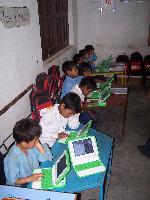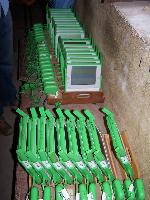After spending most of my time talking or rather writing about One Laptop per Child and Sugar it's always refreshing to actually go into a school and see how things are really working out. Luckily an opportunity to do just that presented itself soon after my arrival here in Kathmandu where I'm currently spending my summer volunteering for OLE Nepal.

Working with E-Paath
OLE Nepal which was founded in early 2007 has currently deployed almost 2200 XOs across schools in 6 districts of the country. On the trip that I was able to join we visited two schools which are both relatively close to Kathmandu. In the first one almost 80 XOs are in use while the second school has slightly more than 100 XOs in operation. In both schools that's a 100% saturation of class 2, 3 and 6 which are the grades that OLE Nepal is currently developing its EPaath learning activities for.
Our main task for the trip was to update the software images on all of these XOs which is a customized version of the stock OLPC images. We had brought along 3 USB keys with the files and then used OLPC's NANDblaster to update all the XOs. With NANDblast you designate one XO to wirelessly transmit the software image from a USB key to the other XOs which need to be put into a receiving mode.

40 XO-1s being NandBlasted
Never having used the technology before I was really quite impressed by it! While it does require you to turn on every single XO, press ESC to get into the firmware prompt and execute a command it's much quicker than having to update every single XO from a USB stick. We (there was 3 of us) swiftly moved from classroom to classroom to set things up and then all we had to do was wait approximately 15 to 20 minutes per classroom for the update to be completed. This is quite a nice example of a technology specifically used by OLPC to make large-scale deployments manageable!
While the XOs were being updated we had a chance to speak to teachers and the headmasters of the schools. One comment that struck me as interesting was a teacher who told me that "the children learn much faster than us". It was also good to hear that the XOs are currently being used for roughly 9 hours per school-week with 3 hours each being spent on English, Maths and Nepali - the three subjects for which OLE Nepal has developed EPaath content so far. Looking at some Journals also revealed that apart from EPaath the most popular activities are Speak and Record.
Part II of this article will be published on Wednesday.


Christoph,
From what you describe looks like only EPaath is used in the classroom. Is this correct?
Is ANY of the standard Sugar activities is used in the classroom? Are they integrated in the program at all?
EPaath has integrated the local alphabet, which apparently is very hard to implement in "standard" applications.
Of course Christoph can answer by himself, but as far as I know he's a bit away from connectivity for a few days.
afaik, very few deployments worldwide use any of the regular Sugar activities as part of regular class time.
This is due to the fact that activities like Paint, Etoys, TamTam -- while powerful -- are not part of the national curriculum nor is it an easy process to integrate them into the curriculum.
Most schools that do use such software in the classroom typically have very well-trained teachers and small class sizes. None of our deployment schools in Nepal have these attributes.
Many of our kids use the other activities besides E-Paath outside of the classroom.
I'm not accusing anybody (OLE Nepal, OLPC or SugarLabs), I'm just surprised.
I would guess that Speak could be used in english and TurtleArt in 6th grade math without major time investment. That's all.
Obviously I'm mistaken.